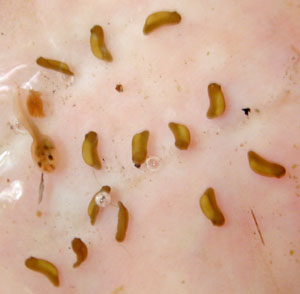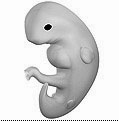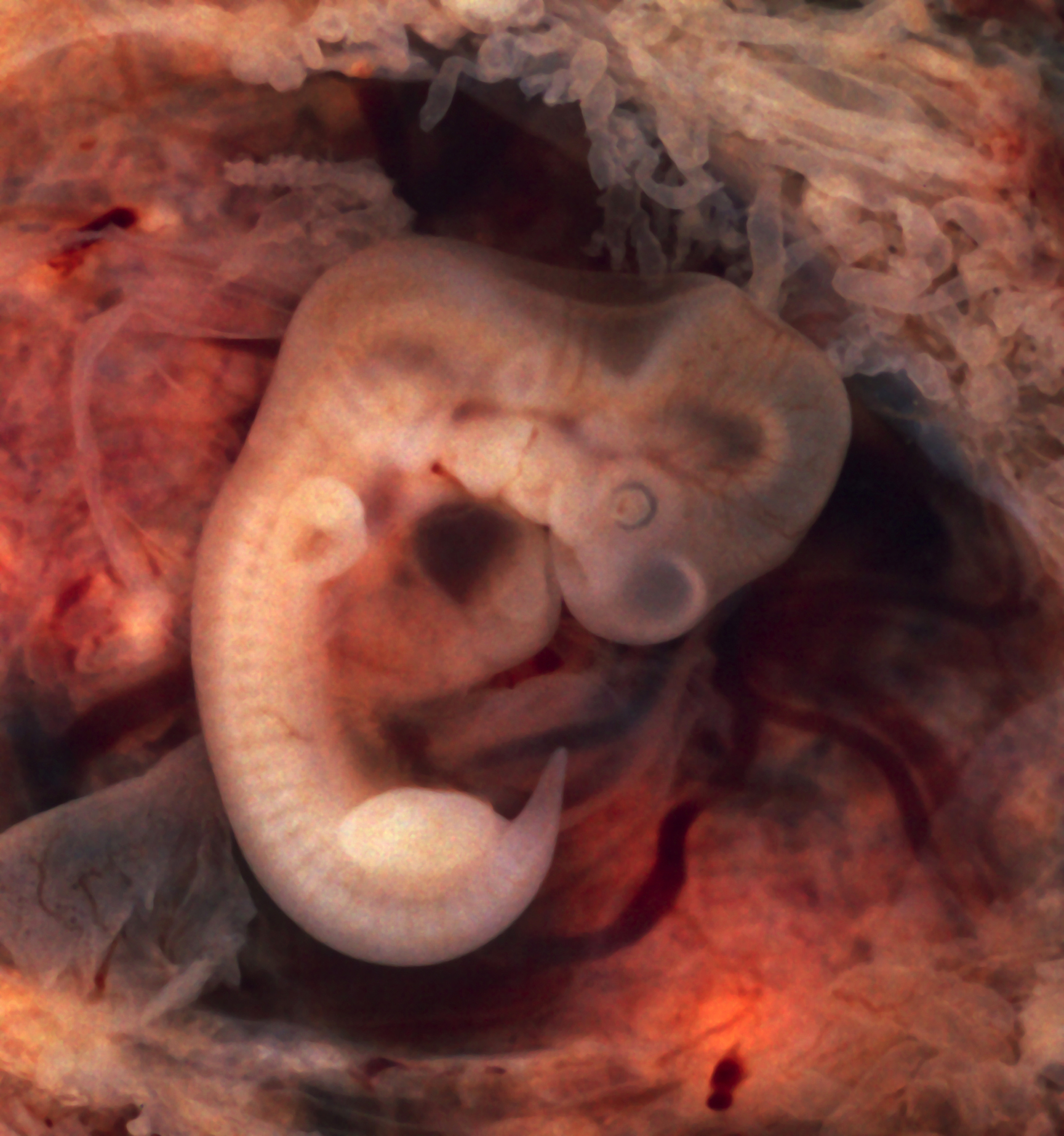Embryo

Editor-In-Chief: C. Michael Gibson, M.S., M.D. [1]
An embryo (from Greek: Template:Polytonic, plural Template:Polytonic, lit. "that which grows," from en- "in" + bryein "to swell, be full") is a multicellular diploid eukaryote in its earliest stage of development, from the time of first cell division until birth, hatching, or germination. In humans, it is called an embryo from the moment of fertilisation until the end of the 8th week, whereafter it is instead called a fetus.
Development
The development of the embryo is called embryogenesis. In organisms that reproduce sexually, once a sperm fertilizes an egg cell, the result is a cell called the zygote that has all the DNA of two parents. The resulting embryo derives 50 percent of its genetic makeup from each parent. In plants, animals, and some protists, the zygote will begin to divide by mitosis to produce a multicellular organism. The result of this process is an embryo.
In animals, the development of the zygote into an embryo proceeds through specific recognizable stages of blastula, gastrula, and organogenesis. The blastula stage typically features a fluid-filled cavity, the blastocoel, surrounded by a sphere or sheet of cells, also called blastomeres.

During gastrulation the cells of the blastula undergo coordinated processes of cell division, invasion, and/or migration to form two (diploblastic) or three (triploblastic) tissue layers. In triploblastic organisms, the three germ layers are called endoderm, ectoderm and mesoderm. However, the position and arrangement of the germ layers are highly species-specific, depending on the type of embryo produced. In vertebrates, a special population of embryonic cells called the neural crest has been proposed as a "fourth germ layer", and is thought to have been an important novelty in the evolution of head structures.
During organogenesis, molecular and cellular interactions between germ layers, combined with the cells' developmental potential or competence to respond, prompt the further differentiation of organ-specific cell types. For example, in neurogenesis, a subpopulation of ectoderm cells is set aside to become the brain, spinal cord and peripheral nerves. Modern developmental biology is extensively probing the molecular basis for every type of organogenesis, including angiogenesis (formation of new blood vessels from pre-existing ones), chondrogenesis (cartilage), myogenesis (muscle), osteogenesis (bone), and many others.
Generally, if a structure pre-dates another structure in evolutionary terms, then it often appears earlier than the other in an embryo; this general observation is sometimes summarized by the phrase "ontogeny recapitulates phylogeny."[2] For example, the backbone is a common structure among all vertebrates such as fish, reptiles and mammals, and the backbone also appears as one of the earliest structures laid out in all vertebrate embryos. The cerebrum in humans, which is the most sophisticated part of the brain, develops last. This rule is not absolute, but it is recognized as being partly applicable to development of the human embryo.
Embryos of plants and animals
- Plants: In botany, a seed plant embryo is part of a seed, consisting of precursor tissues for the leaves, stem (see hypocotyl), and root (see radicle), as well as one or more cotyledons. Once the embryo begins to germinate — grow out from the seed — it is called a seedling. Plants that do not produce seeds, but do produce an embryo, include the bryophytes and ferns. In these plants, the embryo is a young plant that grows attached to a parental gametophyte.
- Animals: The embryo of a placental mammal is defined as the organism between the first division of the zygote (a fertilized ovum) until it becomes a fetus. In humans, the embryo is defined as the product of conception from implantation in the uterus through the eighth week of development. An embryo is called a fetus at a more advanced stage of development and up until birth or hatching. In humans, this is from the eighth week of gestation.
The human embryo
Growth

Template:Seealso Week 1-3 5-7 days after fertilization, the blastula attaches to the wall of the uterus (endometrium). When it comes into contact with the endometrium it performs implantation. Implantation connections between the mother and the embryo will begin to form, including the umbilical cord. The embryo's growth centers around an axis, which will become the spine and spinal cord. The brain, spinal cord, heart, and gastrointestinal tract begin to form.[3]
Week 4-5 Chemicals produced by the embryo stop the woman's menstrual cycle. Neurogenesis is underway, showing brain activity at about the 6th week. The heart will begin to beat around the same time. Limb buds appear where the arms and legs will grow later. Organogenesis begins. The head represents about one half of the embryo's axial length, and more than half of the embryo's mass. The brain develops into five areas, along with vertebra and bones beginning to form. The heart starts to beat and blood starts to flow.[4]
Week 6-8 Myogenesis and neurogenesis have progressed to where the embryo is capable of motion, and the eyes begin to form. Organogenesis and growth continue. Hair has started to form along with all essential organs. Facial features are beginning to develop. At the end of the 8th week, the embryonic stage is over, and the fetal stage begins.[5]
Status
The status of the human embryo is debated by some bioethicists. Some Christian Ethicists believe that an embryo does, in fact, possess personhood. Gilbert Meileander, Christian ethics professor at the private Lutheran university Valparaiso University for example, identifies conception as the point at which a new individual human being comes into existence, since "when sperm and ovum join to form the zygote, the individual's genotype is established."[6] The NIH defines the embryonic stage as the beginning of developed human form [7]
Footnotes
- ↑ 3D Pregnancy (Image from gestational age of 6 weeks). Retrieved 2007-08-28. A rotatable 3D version of this photo is available here, and a drawing is available here.
- ↑ Gould, Stephen. Ontogeny and Philogeny, page 206 (1977): "recapitulation was not 'disproved'; it could not be, for too many well-established cases fit its expectations."
- ↑ NIH Medical Encyclopedia http://www.nlm.nih.gov/medlineplus/ency/article/002398.htm
- ↑ NIH Medical Encyclopedia http://www.nlm.nih.gov/medlineplus/ency/article/002398.htm
- ↑ NIH Medical Encyclopedia http://www.nlm.nih.gov/medlineplus/ency/article/002398.htm
- ↑ Gilbert Meilander, Bioethics: A Primer for Christians (2nd ed.; Grand Rapids: Eerdmans, 2005), p. 29.
- ↑ NIH Medical Encyclopedia http://www.nlm.nih.gov/medlineplus/ency/article/002398.htm
See also
- Embryogenesis
- Embryology
- In vitro fertilization
- Plant embryogenesis
- Embryo space colonization
- Pregnancy
- Embryo adoption
- Sexual
Template:Start box
Template:Succession box
Template:End box
External links
| Wikimedia Commons has media related to Embryology. |
- Chart of human fetal development
- A Comparative Embryology Gallery
- Development of the human embryo
- The Visible Embryo from fertilization to birth
- The Human Fertilisation and Embryology Authority (HFEA)
- The Developing Human (Keith L.Moore) http://www.youtube.com/watch?v=Rb0uZefwQnc
Template:Jb1 Template:WH Template:WS
ar:جنين ca:Embrió cs:Embryo da:Embryon de:Embryo et:Embrüo eo:Embrio fa:جنین gl:Embrión io:Embriono id:Embrio it:Embrione lb:Embryo lt:Gemalas nl:Embryo no:Embryo oc:Embrion simple:Embryo sk:Embryo sl:Zarodek sh:Zametak fi:Alkio sv:Embryo uk:Ембріон ur:جنین